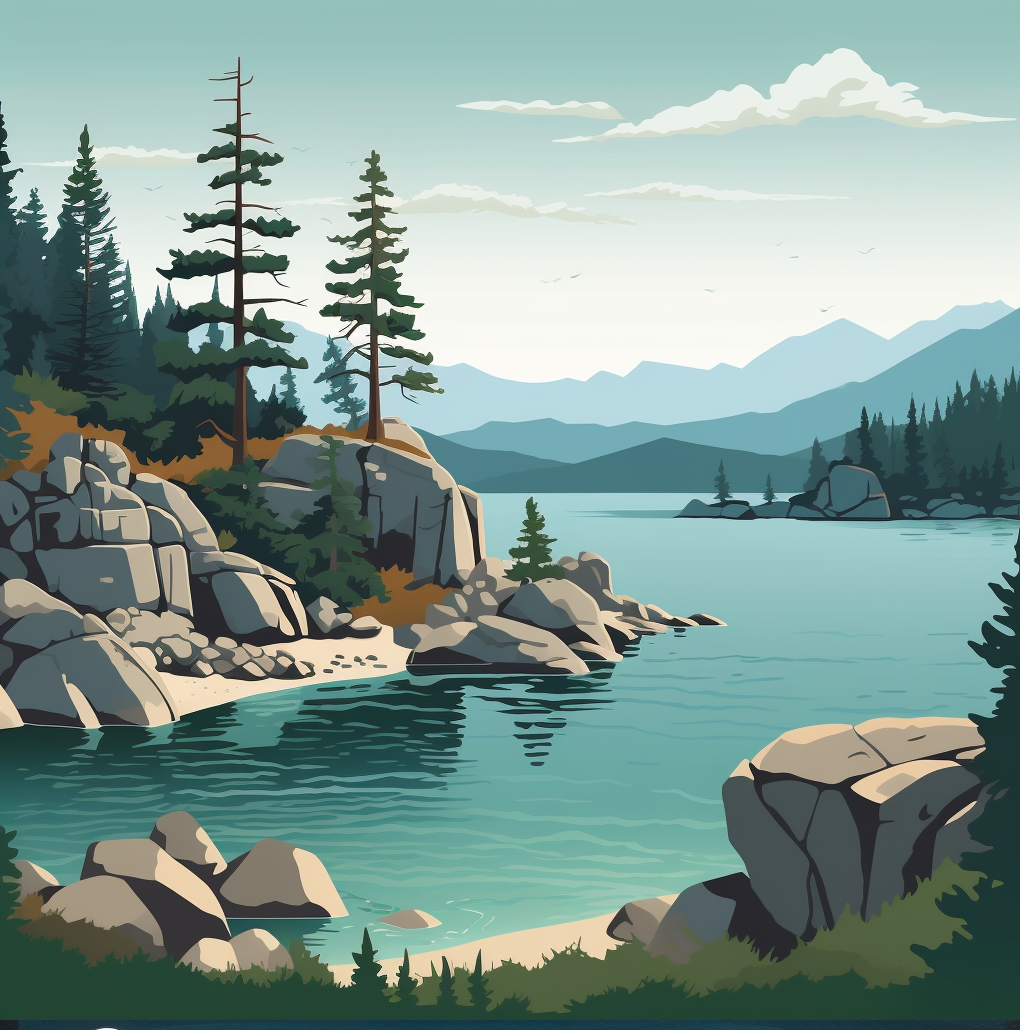————————————————————
This opinion column was submitted by Pamela Mahoney Tsigdinos, a Tahoe resident who volunteers with grassroots Tahoe Basin groups.
More buildings and more people may work in a place with ample roads and infrastructure, situated far from deeply forested wildfire territory and with easily accessible year-round public transportation safe from extreme weather. But endless development is not practical in the geographically constrained, high elevation, towering tree-filled Tahoe Basin.
Yet public officials, as if divorced from reality, continue to advance expansive new development proposals calling for greater building heights and increased population density across the Tahoe Basin. These proposals purport to address long-term affordable housing problems. Ironically, the housing issues have been exacerbated by shortsighted or long-deferred governmental policy decisions that prioritized tourism over the needs of local residents, businesses and the environment.
The lack of affordable Tahoe housing, the new cudgel used to justify large, unsustainable development, isn’t new. Finger-pointing between jurisdictions is a long-standing, well-documented problem. In 2001 (https://ntpac.us9.list-manage.com/track/click?u=c2651ac4497b4fa0886fa6f7f&id=37cbba969e&e=05ca50f483) , for example, the Washoe County Commission earned criticism for “not doing its fair share” to provide affordable housing.
Twenty-two years on, Tahoe affordable housing is still in short supply. The scapegoat used today by county officials, developers and the Tahoe Regional Planning Authority to explain the lack of Tahoe’s affordable housing is “NIMBYs” — aka resident constituents. Yet, it is government officials who set (https://ntpac.us9.list-manage.com/track/click?u=c2651ac4497b4fa0886fa6f7f&id=4770b5ce2d&e=05ca50f483) and enforce policies, investors who buy up properties to market to tourists, and developers who decide what and where the greatest return on investment lies. The majority of policy-setting officials, investors and developers live elsewhere.
** Final decision on condo zoning looms June 28
————————————————————
Tahoe residents want safe and neighborly communities (https://ntpac.us9.list-manage.com/track/click?u=c2651ac4497b4fa0886fa6f7f&id=d4234617d0&e=05ca50f483) with thriving small businesses, schools, local health care and first responders. The desire for healthy communities drove more than decade of resident input and local planning starting around the time TRPA abdicated its responsibility (https://ntpac.us9.list-manage.com/track/click?u=c2651ac4497b4fa0886fa6f7f&id=5f36aa50f9&e=05ca50f483) to act as an independent bi-state Tahoe Basin environmental steward and natural resource conservator. One of six area plans (https://ntpac.us9.list-manage.com/track/click?u=c2651ac4497b4fa0886fa6f7f&id=57928a47c2&e=05ca50f483) , Washoe County’s Tahoe Area Plan involves some 31 square miles located along the east and north shores of Lake Tahoe. Incline Village and Crystal Bay are the sole communities within it.
Adopted in 2021, the plan (Community Character pp. 1-3) (https://ntpac.us9.list-manage.com/track/click?u=c2651ac4497b4fa0886fa6f7f&id=fd645882b4&e=05ca50f483) states “Washoe County worked with the Incline Village and Crystal Bay community for fourteen years to develop this plan.” That’s thousands of volunteered residents’ hours and days. Among the conclusions: single-family condominiums in Special Area 1 (https://ntpac.us9.list-manage.com/track/click?u=c2651ac4497b4fa0886fa6f7f&id=32a23805a8&e=05ca50f483) of the Incline Village Town Center would only be permitted if part of a mixed-use development, or if they were affordable housing.
At the end of 2022, with little warning, a significant proposed change surfaced. Alarmed that land earmarked for affordable housing now advertised condos starting at $2.5 million, more than 40 residents participated on Jan. 3 at the Incline Village/Crystal Bay Citizens Advisory Board (https://ntpac.us9.list-manage.com/track/click?u=c2651ac4497b4fa0886fa6f7f&id=89797a0927&e=05ca50f483) meeting (note: The Tahoe Area Plan item begins at minute 45.05). Not a single resident at the meeting expressed support to amend the plan. Still, on Jan. 17, (https://ntpac.us9.list-manage.com/track/click?u=c2651ac4497b4fa0886fa6f7f&id=2775a54038&e=05ca50f483) Washoe County Commissioners blindly followed Commissioner Alexis
Hill’s recommendation to amend Special Area 1 zoning to allow for luxury condo development (https://ntpac.us9.list-manage.com/track/click?u=c2651ac4497b4fa0886fa6f7f&id=61983b3859&e=05ca50f483) .
The TRPA governing board (https://ntpac.us9.list-manage.com/track/click?u=c2651ac4497b4fa0886fa6f7f&id=8c33ce58cd&e=05ca50f483) Regional Plan Implementation Committee, on which Hill also sits, heard many resident concerns (https://ntpac.us9.list-manage.com/track/click?u=c2651ac4497b4fa0886fa6f7f&id=87e2e3f9ee&e=05ca50f483) in March 2023 (https://ntpac.us9.list-manage.com/track/click?u=c2651ac4497b4fa0886fa6f7f&id=acb7e51d30&e=05ca50f483) . The final TRPA governing board decision is due June 28. If approved, this plan amendment will set a precedent for more building height and increased density throughout the Tahoe Basin. The most enthusiastic support comes from, yes, developers.
** Tahoe in a ‘double hazard zone’
————————————————————
Residents of rural Kings Beach, Tahoe City and Tahoe Vista first voiced their disapproval of more congestion and high price points at a Placer County (https://ntpac.us9.list-manage.com/track/click?u=c2651ac4497b4fa0886fa6f7f&id=4c1201a7ed&e=05ca50f483) meeting. Rather than reverse problematic policies involving short-term rentals, which contributed to housing shortages, TRPA is on the precipice of doubling down on bad decision-making. It’s considering an urban planning approach (https://ntpac.us9.list-manage.com/track/click?u=c2651ac4497b4fa0886fa6f7f&id=e3f687ea0d&e=05ca50f483) devised by a consulting firm with past projects in San Antonio, Austin and Sacramento. None of those cities lie within a pine forest or rely on an already-overburdened (https://ntpac.us9.list-manage.com/track/click?u=c2651ac4497b4fa0886fa6f7f&id=3cc081aced&e=05ca50f483) two-lane roadway that doubles as a lifeline evacuation path for tens of thousands of visitors and residents. Gridlock (https://ntpac.us9.list-manage.com/track/click?u=c2651ac4497b4fa0886fa6f7f&id=1e9529f0be&e=05ca50f483) already exists.
Nightmarish wildfires are occurring with more frequency in the American West and in forested areas north across Canada (https://ntpac.us9.list-manage.com/track/click?u=c2651ac4497b4fa0886fa6f7f&id=54f43d5996&e=05ca50f483) . In 2022 a Stanford study (https://ntpac.us9.list-manage.com/track/click?u=c2651ac4497b4fa0886fa6f7f&id=5ec940e87d&e=05ca50f483) made headlines when it called out the dangers of development into wildland “double hazard zones.”
The authors noted, “people provide the vast majority of ignitions for fires that then torch the abundant vegetation and threaten human lives and structures. Simply having more people and homes nestled among flammable trees, chaparral and grasses add to wildfire risks.” This transition zone is referred to as the wildland-urban interface (https://ntpac.us9.list-manage.com/track/click?u=c2651ac4497b4fa0886fa6f7f&id=d0dee89041&e=05ca50f483) .
Tahoe is uniquely at risk. It is home to some 57,000 people. Another 15 to 20 million visit each year, many unfamiliar with fire prevention and safety practices. Resort operator Alterra Mountain Company, in a revised draft environmental impact report, concedes it would take 11 hours to escape three miles (https://ntpac.us9.list-manage.com/track/click?u=c2651ac4497b4fa0886fa6f7f&id=b8c688bfae&e=05ca50f483) from Palisades Tahoe to Highway 89. Those stuck in the valley would be told to “shelter in place” in a parking lot or on a golf course. Sierra Watch reports (https://ntpac.us9.list-manage.com/track/click?u=c2651ac4497b4fa0886fa6f7f&id=5feaac8553&e=05ca50f483) it is again fighting expansion plans first attempted in 2011.
Looking ahead, policymakers also must consider the fire risk associated with the proliferation of electric vehicles, including e-bikes, that rely on fire-prone lithium-ion batteries. This week AP reported (https://ntpac.us9.list-manage.com/track/click?u=c2651ac4497b4fa0886fa6f7f&id=959a35296c&e=05ca50f483) there have been more than 100 fires and 13 deaths linked to battery explosions in New York City alone. Lithium-ion battery fires burn in a different way than a traditional gas fire, according to Autoweek (https://ntpac.us9.list-manage.com/track/click?u=c2651ac4497b4fa0886fa6f7f&id=c3222bff30&e=05ca50f483) , “with the blaze lasting longer and burning hotter than a gas fire.”
** Evacuation plans needed before next wildfire strikes
————————————————————
At some point officials making policy for Tahoe must think about a comprehensive strategy to get people out, not just pack them in.
This public safety issue has been raised countless times by residents throughout the Tahoe Basin. Many have pleaded with county and TRPA officials for an updated comprehensive environmental impact analysis of the new development projects approved and in the pipeline (https://ntpac.us9.list-manage.com/track/click?u=c2651ac4497b4fa0886fa6f7f&id=8f37e03120&e=05ca50f483) , and asked for a comprehensive fire evacuation plan.
For example, at the May 2023 Incline Village/Crystal Bay Citizen’s Advisory Board (https://ntpac.us9.list-manage.com/track/click?u=c2651ac4497b4fa0886fa6f7f&id=67109fec3f&e=05ca50f483) (38.34 minutes) Ryan Sommers of North Lake Tahoe Fire Protection District and TRPA’s Jeff Cowen took questions from community members concerned about wildfire evacuation and ill-conceived development proposals. There was little in the way of specifics about how various government agencies are coordinating to ensure safe passage. Residents continue to push for answers only to get stiff-armed.
Common sense dictates that officials establish, ahead of the next wildfire and before more development, a reality-based plan to evacuate tens of thousands of visitors, residents and workers who live out of the Tahoe Basin. Consider that the horrific Camp Fire in Paradise, fire moved 100 yards (https://ntpac.us9.list-manage.com/track/click?u=c2651ac4497b4fa0886fa6f7f&id=5830ec2e0e&e=05ca50f483) — the entire length of a football field — every second. Since smoke also kills, “sheltering in place” is not an option.
Concerns about greater density and new development in wildfire prone areas have led to lawsuits in California (https://ntpac.us9.list-manage.com/track/click?u=c2651ac4497b4fa0886fa6f7f&id=1fe220b171&e=05ca50f483) . Several have successfully halted development as there was no safe and expedient way to evacuate inhabitants.
In Colorado, a 55-page after action (https://ntpac.us9.list-manage.com/track/click?u=c2651ac4497b4fa0886fa6f7f&id=774114fa2a&e=05ca50f483) fire report noted: “Among the challenges … were problems with public notification systems, including gaps in cellphone alerts and siren system coverage, miscommunication between various first responder agencies because of confusion over radio channels, lack of adequate personal protective equipment for fire and police personnel who were actively working the blaze and no defined strategy for the evacuation, including a plan for hordes of vehicles fleeing oncoming flames.”
So, what it is the unified Tahoe evacuation plan? Seems like TRPA, which receives hundreds of millions of dollars in federal (https://ntpac.us9.list-manage.com/track/click?u=c2651ac4497b4fa0886fa6f7f&id=943e87db73&e=05ca50f483) and state funding is a good place to ask this question.
In sum, public officials and their allies are pushing a development concept that the fragile Tahoe environment, limited local infrastructure and public safety cannot support. Please make your voices heard to TRPA on June 28, 2023 (https://ntpac.us9.list-manage.com/track/click?u=c2651ac4497b4fa0886fa6f7f&id=fdb154964b&e=05ca50f483) or email public comments to mambler@trpa.gov (mailto:mambler@trpa.gov) .
Pamela Mahoney Tsigdinos is a Tahoe resident who volunteers with grassroots Tahoe Basin groups.


